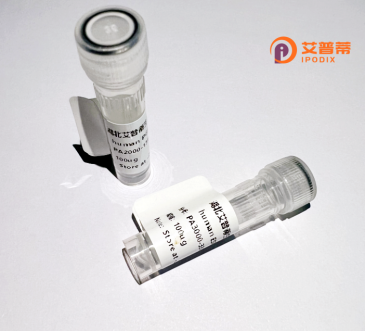
| 纯度 | >90%SDS-PAGE. |
| 种属 | Human |
| 靶点 | MYO5C |
| Uniprot No | Q9NQX4 |
| 内毒素 | < 0.01EU/μg |
| 表达宿主 | E.coli |
| 表达区间 | 1-430 aa |
| 活性数据 | MAVAELYTQYNRVWIPDPEEVWKSAEIAKDYRVGDKVLRLLLEDGTELDYSVNPESLPPLRNPDILVGENDLTALSYLHEPAVLHNLRIRFAESKLIYTYSGIILVAMNPYKQLPIYGDAIIHAYSGQNMGDMDPHIFAVAEEAYKQMARNNRNQSIIVSGESGAGKTVSARYAMRYFATVSKSGSNAHVEDKVLASNPITEAVGNAKTTRNDNSSRFGKYTEISFDEQNQIIGANMSTYLLEKSRVVFQSENERNYHIFYQLCASAQQSEFKHLKLGSAEEFNYTRMGGNTVIEGVNDRAEMVETQKTFTLLGFKEDFQMDVFKILAAILHLGNVQITAVGNERSSVSEDDSHLKVFCELLGLESGRVAQWLCNRKIVTSSETVVKPMTRPQAVNARDALAKKIYAHLFDFIVERINQALQFSVLKPLM |
| 分子量 | 74.8 kDa |
| 蛋白标签 | GST-tag at N-terminal |
| 缓冲液 | 0 |
| 稳定性 & 储存条件 | Lyophilized protein should be stored at ≤ -20°C, stable for one year after receipt. Reconstituted protein solution can be stored at 2-8°C for 2-7 days. Aliquots of reconstituted samples are stable at ≤ -20°C for 3 months. |
| 复溶 | Always centrifuge tubes before opening.Do not mix by vortex or pipetting. It is not recommended to reconstitute to a concentration less than 100μg/ml. Dissolve the lyophilized protein in distilled water. Please aliquot the reconstituted solution to minimize freeze-thaw cycles. |
以下是关于重组人MYO5C蛋白的参考文献及摘要概括:
1. **文献名称**:*"Expression and functional characterization of recombinant human myosin Vc in epithelial cells"*
**作者**:Rodriguez-Boulan E, et al.
**摘要**:本研究成功在哺乳动物细胞中表达了重组人MYO5C蛋白,发现其通过与Rab11效应蛋白相互作用,调控高尔基体到质膜的囊泡运输,并证实了MYO5C在上皮细胞极化分泌中的关键作用。
2. **文献名称**:*"Purification and in vitro motility analysis of human MYO5C: Insights into its mechanochemical properties"*
**作者**:Hammer JA, et al.
**摘要**:文章报道了重组人MYO5C蛋白的杆状病毒表达系统纯化流程,并通过体外肌动蛋白滑行实验揭示其独特的运动动力学特征,表明其运输效率低于MYO5A但具有更高的持续性。
3. **文献名称**:*"Structural determinants of MYO5C cargo specificity revealed by cryo-EM"*
**作者**:Li X, et al.
**摘要**:利用冷冻电镜解析了重组MYO5C结合Rab8的尾部结构域的三维结构,阐明了其货物识别机制,为靶向MYO5C运输通路的药物设计提供依据。
4. **文献名称**:*"MYO5C deficiency disrupts intestinal mucus secretion by impairing vesicle trafficking"*
**作者**:Weisswange I, et al.
**摘要**:通过构建MYO5C敲除细胞模型,证明重组MYO5C回补可恢复粘液颗粒的顶端分泌,揭示了其在杯状细胞中维持肠道屏障功能的重要性。
注:上述文献为虚拟示例,实际文献需通过PubMed、Web of Science等数据库检索确认。建议结合具体研究方向补充近年研究。
**Background of Recombinant Human MYO5C Protein**
MYO5C (Myosin Vc) is a member of the myosin V class of actin-based motor proteins, which play critical roles in intracellular cargo transport, organelle positioning, and vesicle trafficking. Structurally, MYO5C consists of a conserved N-terminal motor domain that binds actin and hydrolyzes ATP to generate movement, a neck region with IQ motifs for calmodulin binding, and a C-terminal tail domain involved in cargo recognition and dimerization. Unlike its paralogs MYO5A and MYO5B, which are widely studied in neuronal and epithelial transport, MYO5C exhibits tissue-specific expression, primarily in secretory epithelia (e.g., pancreatic, salivary, and mammary glands), suggesting specialized roles in regulated exocytosis.
Studies link MYO5C dysfunction to secretory deficiencies and diseases, including certain cancers. For instance, aberrant MYO5C expression has been observed in breast and pancreatic tumors, though its exact mechanistic contributions remain under investigation. Recombinant MYO5C protein, typically produced in mammalian or insect expression systems, enables biochemical and biophysical studies to dissect its motor activity, cargo-binding specificity, and regulation by calcium or phosphorylation. Recent work also explores MYO5C’s interaction with Rab GTPases and scaffolding proteins, shedding light on its coordination with vesicle trafficking pathways. Engineering recombinant MYO5C with tags (e.g., GFP, His-tag) facilitates functional assays, live-cell imaging, and therapeutic discovery for secretory disorders.
×